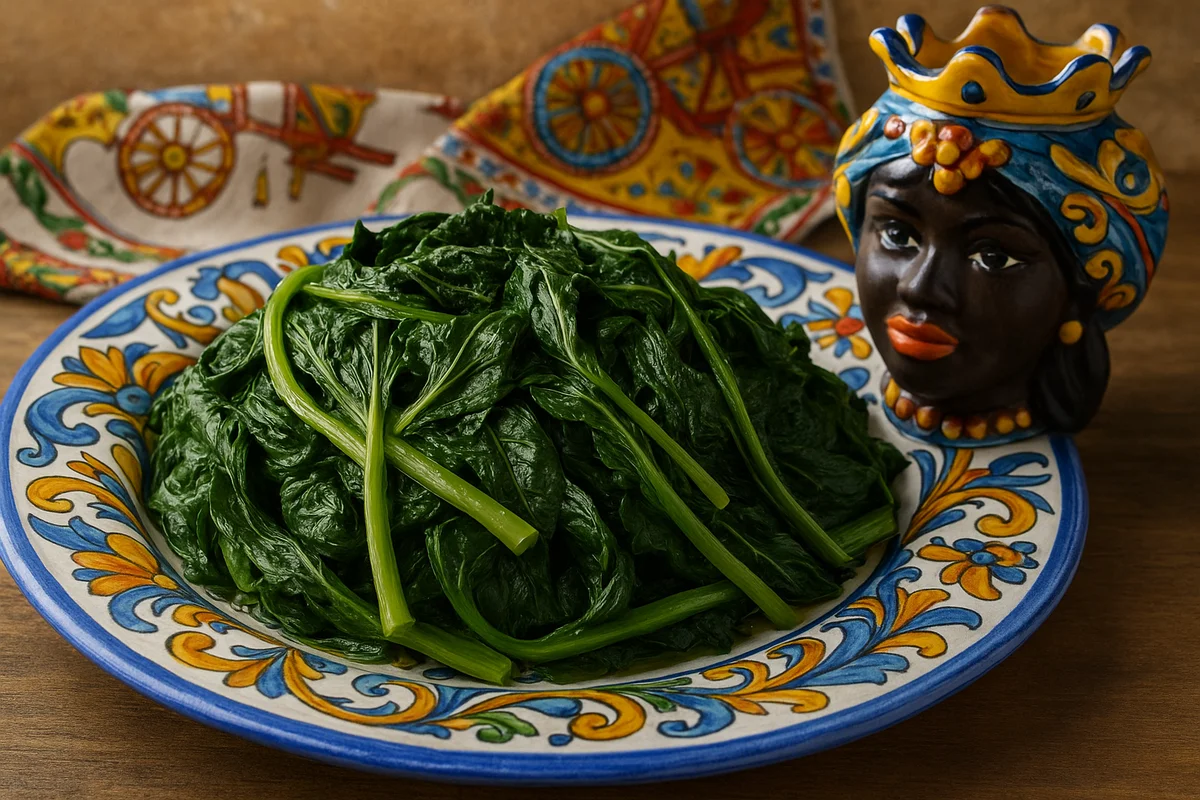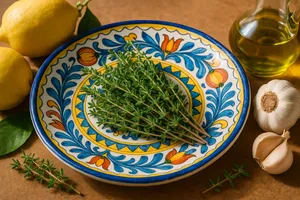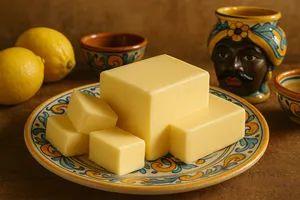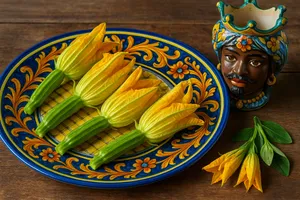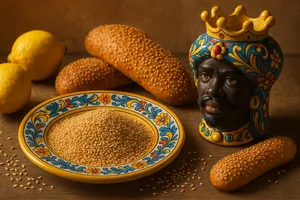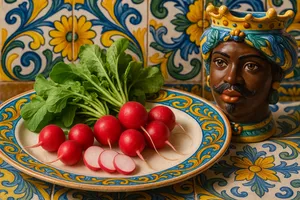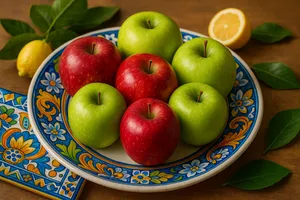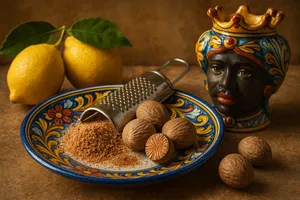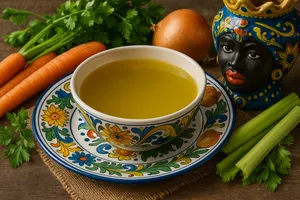Overview
Chicory is a wild and cultivated herb belonging to the Asteraceae family, widespread in Sicily where it grows abundantly in fields, along roadsides, and in vegetable gardens. This vegetable, with its characteristic bitter flavour, has long held an important place in traditional Sicilian cookery, particularly in the humble, rural tradition that made the most of the island’s wild greens.
In the island’s culinary tradition, chicory features in simple yet flavourful dishes: boiled and sautéed, cooked in soups with legumes, or eaten raw in salads when the leaves are still tender. Its distinctive bitterness, not always appreciated at first, becomes pleasant and sought-after once one learns to recognise its qualities and pair it correctly.
Characteristics
Chicory has elongated, serrated, and lightly toothed leaves, in deep green or reddish tones depending on the variety. The raw leaves have a slightly firm texture that becomes tender with cooking. The basal rosette can reach 30–40 centimetres in diameter.
The flavour is characteristically bitter, with intensity varying by variety, season, and cultivation method. The bitterness is due to the presence of inulin and other beneficial compounds. Its aroma is herbal and fresh, typical of wild greens.
The flowers, which appear when the plant goes to seed, are sky-blue and highly decorative, but signal that the leaves have become too tough and bitter to eat.
Varieties
Wild chicory
Grows spontaneously in fields and along roadsides. It has narrower, more serrated leaves and a very bitter flavour. This is the variety traditionally foraged in Sicily for culinary use.
Catalonian chicory
A cultivated variety with long, narrow, dark green leaves. Less bitter than the wild type and much appreciated in cooking. Includes several sub-varieties such as “puntarelle”.
Radicchio
Forms a compact head of leaves, red or variegated in colour. Milder and crisp, it is used mainly raw in salads.
Sugarloaf chicory
Forms an elongated head of pale leaves, crisp and sweet. Excellent raw in salads.
Seasonality
In Sicily, wild chicory is harvested from autumn to spring, with the best period between November and March. Cultivated varieties are available year-round but are at their finest in the colder months.
The youngest, most tender leaves, harvested before flowering, are the most prized. As spring arrives and flowering begins, the leaves become progressively tougher and more bitter.
Culinary use
In Sicilian cooking, chicory is used in numerous preparations.
Sautéed chicory
The leaves are boiled in salted water, then sautéed with garlic, extra virgin olive oil, chilli pepper, and sometimes anchovies. This is the classic, most widespread side dish.
Chicory and legume soup
Chicory is cooked together with beans, chickpeas, or broad beans to create rustic, nourishing soups. Pasta or stale bread is added to make a complete dish.
Chicory and potatoes
A typical preparation in which chicory and potatoes are cooked together, then seasoned with oil, garlic, and chilli. A humble yet flavourful dish from the rural tradition.
Chicory frittata
Boiled and chopped chicory is mixed with eggs to prepare rustic frittatas, often enriched with cheese.
Raw chicory
The less bitter varieties and the youngest leaves are eaten raw in salads, often paired with oranges, olives, and onions.
Preparation
Wild chicory must be cleaned by removing the roots, damaged leaves, and the toughest parts of the stems. It should be washed thoroughly in several changes of water to eliminate soil and impurities.
To reduce bitterness, it may be soaked in cold water for 30 minutes to an hour before cooking. Boiling it in plenty of salted water for 10–15 minutes further softens the bitterness.
After cooking, it is important to squeeze the chicory well to remove excess water, which would otherwise make preparations too moist. It can then be sautéed or used in other recipes.
Storage
Fresh chicory keeps in the refrigerator for 3–4 days in the vegetable drawer, wrapped in a damp cloth or paper bag. It should not be washed before storage.
Boiled chicory keeps in the refrigerator for 2–3 days in a closed container, covered with a drizzle of oil. It also freezes well: once boiled and squeezed, it can be frozen in portions and keeps for 6–8 months.
Tips for buying
When buying fresh chicory, choose bunches with firm leaves of a deep green colour, without yellowing or wilted parts. The leaves should be crisp, not limp.
Avoid chicory with excessively tough or woody stems, signs of older plants. The presence of flowers indicates that the plant has gone to seed and the leaves will be too bitter and tough.
Prefer chicory that is local and in season. Wild varieties foraged in the fields have a more intense flavour but are also more nutritious.
Nutritional properties
Chicory is a very light vegetable: 100 grams provide only 15–20 calories. It consists of more than 90% water and is rich in fibre, which promotes intestinal transit and a feeling of fullness.
It is an excellent source of vitamins, particularly vitamins A, C, K, and B-group vitamins. It contains important minerals such as potassium, calcium, iron, and phosphorus. Inulin, a soluble fibre present in abundance, has beneficial prebiotic effects on the gut flora.
It contains bitter substances with digestive, cleansing, and tonic properties. In Sicilian folk medicine it was considered a liver purifier and eaten in spring as a “cleanser” after the winter months.
Curiosities
In Sicilian tradition, wild chicory was regarded as a humble yet precious food, gathered freely in the fields and used especially by farming families. Its gathering was a family activity, with entire households heading to the fields on holidays.
In some parts of Sicily, chicory was eaten raw with bread and olives as a field snack, a simple yet nourishing bite for those working the land.
The chicory’s blue flowers have inspired Sicilian poets and artists. According to a popular legend, these flowers represent the eyes of a nymph transformed into a plant for unrequited love.
During the Second World War, when real coffee was unobtainable, roasted and ground chicory roots were used as a substitute, creating a beverage known as “chicory coffee”, still remembered today by some older Sicilians.

